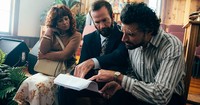“Hidalgo" - Movie Review
- Annabelle Robertson Entertainment Critic
- Updated Aug 03, 2007

Release Date: March 5, 2004
Rating: PG-13 (for adventure violence and some mild innuendo)
Genre: Action/Drama/Adventure
Director: Joe Johnston
Actors: Viggo Mortensen, Zuleikha Robinson, Omar Shariff, Louise Lombard, Elizabeth Berridge, J.K. Simmons
At first I was confused. Then I was disappointed. Then I was mad.
Set in 1890, “Hidalgo” tells the story of the legendary Frank T. Hopkins (Viggo Mortensen), a dispatch courier for the Pony Express who unwittingly delivers orders for the Native American massacre at Wounded Knee. Filled with horror and remorse, Hopkins turns to booze and joins Buffalo Bill’s (J.K. Simmons) unlikely but wildly popular rodeo show.
When the Arab “sheik of sheiks” (Omar Shariff) hears that Hopkins is one of the best riders in the West, he issues a challenge for him to ride in the 3,000 mile Ocean of Fire race across the desert. No American has ever entered, much less won, and certainly not on an impure Mustang like “Hidalgo.” Hopeful of winning the $100,000 purse, Hopkins goes to Arabia, where he must combat mother nature as well as human nature.
The opening scenes are highly reminiscent of “The Last Samurai,” but Hopkins’ trip soon morphs into “Lawrence of Arabia.” The race begins, but when the sheik’s daughter is kidnapped, Hopkins saves her while battling swashbuckling Bedouins, making me feel like I had mistakenly hit the “play” button on my VCR and turned on “Indiana Jones.” When we return to the race, it’s “Seabiscuit” reincarnated. Then no, we’re ending on “Dances with Wolves,” with Hopkins embracing his inner Native American.
We’re talking cinematic schizophrenia at its worst. Of course, the so-called “true story” that inspired the film has its share of inconsistencies, too.
|
OBJECTIONABLE CONTENT: "Hidalgo" |
|
|
• = Mild •• = Average ••• = Heavy •••• = Extreme |
|
|
Adult Themes: |
•• |
|
Drugs/Alcohol Content: |
•• |
|
Language/Profanity: |
• |
|
Sexual Content/Nudity: |
• |
|
Violence: |
••• |
According to American Western Magazine, the real Frank T. Hopkins spent most of his life bragging about a 3,000-mile race that he had supposedly won in the deserts of Arabia, without any documented evidence to back up his claims. The self-proclaimed legend also insisted that he had become a dispatch rider for the US government on his twelfth birthday in 1877, after which he then worked as a buffalo hunter, Indian fighter, African explorer, endurance racer, trick rider, bounty hunter, Rough Rider, big game guide, secret agent, Pinkerton detective and star of the Buffalo Bill Cody’s Wild West show.
So maybe Hopkins was the one who forgot to take his meds – not the filmmakers.
The Arabs in the film are either royalty (including a beautiful feminist princess, played by Zuleikha Robinson), lackeys or cackling murderers. Initially, I was glad that Hollywood wasn’t catering to the politically correct agenda. Then I saw the end of the film, where Hopkins prays to his ancestors in the sing-song voice of his long-buried Native heritage. The spirits of his dead mother and grandmother appear and give him the strength to go on. We also saw this Native American religion played out in screenwriter John Fusco’s, “Stallion: Spirit of the Cimarron.”
In addition to this disturbing scene, there are also negative references to God. One contestant insists, after an accident, that it is God’s will for him to die. “What about your will? What about your horse’s will?” Hopkins says, clearly mocking the concept of anything but self will. Moreover, the fact that the Arab’s deity insists on his follower’s painful death implies that if God does exist, He is a cruel one indeed. A Mustang preservationist, Fusco obviously has a spiritual agenda as well as an environmental one.
There is also a certain amount of violence that will be disturbing for children, including beheadings, stabbings, shooting, fighting and a horse being impaled. Extended scenes with subtitles will be frustrating for the younger ones, although they added to the veracity.
In terms of performance values, Mortensen has one facial expression and one tone of voice – although he’s believable as a gruff, dumb cowboy that adores his horse. (The fortunate actor actually got to keep one of the animals after filming.) Sharif does a decent job, turning a silly role into a good one, even if it does seem clichéd to have Shariff playing an Arab yet again. Louise Lombard, as the chilly English lady who wants Hopkins in her bed and her mare at the finish, is appropriately haughty.
The real star of the show, however, is the film’s namesake. Played by five American Paint Horses, we can almost hear Hidalgo speaking. Johnston makes the inspired choice of giving him not one but several close-ups, and in so doing allows the horse to communicate with the audience. This is Disney at its best.
The musical score is overdone – again, pure “Indiana Jones” – with soaring violins and pounding drums for suspense. I saw inspiration in Shelly Johnson’s cinematography, but there were so many Marlboro ad copycat shots that I actually winced.
It’s not original, it’s not historical and it has a clear spiritual agenda – which is far from Christian. This is something we’re seeing more and more of from the Disney-owned Buena Vista Pictures. Overall, “Hidalgo” is a real disappointment.




















